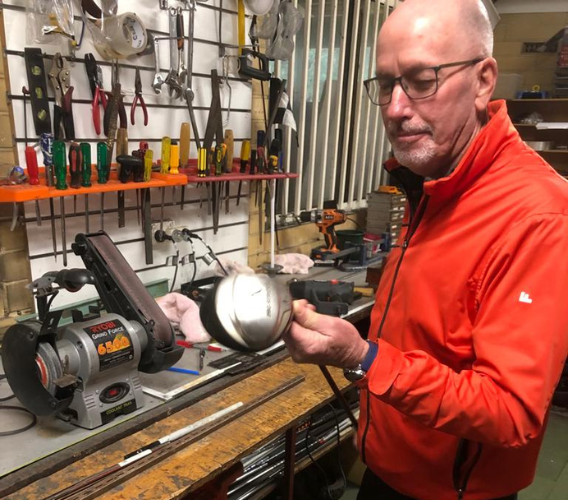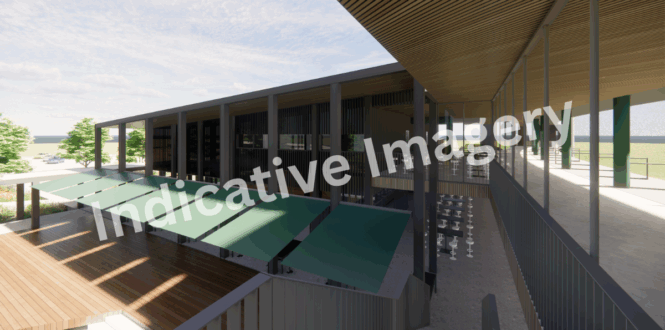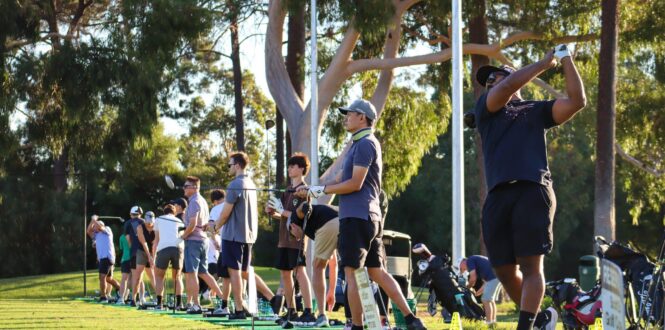
Interview with Tim Holmes – Collier Park Golf Pro
Posted on August 17, 2022
Tell us a bit about yourself and your role at Collier Park.
My name is Tim Holmes and I have worked at Collier Park since March 2012.
Previous to Collier Park, I have worked at Lake Karrinyup, Marangaroo Golf Course and prior to that, I was the pro at Royal Perth Golf Club from 1982 to 1995. I did about ten years teaching primarily at Marangaroo Golf Course as well as working in the pro shop.
Then one day a guy offered me a job that was completely outside of golf and I had a crack at that in the air conditioning industry. So, I can design your air conditioning system for you and even install it if push comes to shove! That business was good, but then the guy sold the business so I decided to try and get back into the golf industry.
I managed to get a job here with the previous managers of Collier Park Golf Course, then four and a half years ago when Clublinks came onto the scene, I was fortunate enough to keep my position with them. I’ve been sort of around the pro shop, running the course, doing a bit of coaching, doing repairs and stuff like that; because I’m probably the guy that’s Mr. Do-It-All for all aspects of the industry. I like that variety and I know the trend in the modern world is to specialise, but Golf is a game that has many facets to it, so I like to do it all.
Over the years I’ve been lucky to travel a bit and study the game in different parts of the world. I spent some time in America, in very, very esteemed company in the golf industry, people that were the golf club designers of some of the best golf clubs in the world. There was a fella called Dig Delacruz who I spent a bit of time with. I think I learned more in two days listening to him talking about golf club design than I’ve learned in 20 years!
When did you start your professional career in Golf?
I started in January 1972, so that’s 50 years and eight months.
I was trained by the pro there (at Royal Perth Golf Club) who was probably the best club maker in WA, named Chaz Newman. Chaz was a very good club maker and coach. He’d been the pro there since 1948 and he’d continue on there until 1980. I took over as the club pro there in 1982, but Chaz trained me in everything from club making, teaching, and everything else.
So we can assume then that you grew up playing golf?
I played a little golf but I knew early on that I was never going to be a tournament player. I had a crack at the tour in 1977 and made my drive across the country, as you did in those days, it was an adventure! I saw Greg Norman and went, “Well I can’t hit it as well as him, so I think I better go back and learn how to teach”. But no, the goal was always to be a professional in the industry rather than as a tournament player.

Can you talk to the production of golf clubs a little more?
A golf club comes down to how well it’s put together, how well the components are matched to your particular shafts and grips, and there’s a bit to it in terms of specifications. You can’t put the wrong head on the wrong shaft and have it work properly. Manufacturers spend a lot of time doing this when they’re testing for the release of new models, and they recommend a particular shaft for that head. It doesn’t mean that you have to go with that shaft, but it does mean it is more suited.
I get people coming in all of the time when they change the length of their driver and they don’t have a clue about what that’s going to do to the balance and how it’s going to feel. Sometimes you have to tell them no, I won’t do that, because you’re going to ruin a good golf club! For example, a men’s and ladies golf club has about one inch difference in length, but if you lengthen the club by an inch from a standard men’s club, you’re then making it that much heavier again. Some people come in and go, “Oh, I want to get a 46-inch-long driver, because so and so has got one.”
I was going to ask where does that mindset typically come from?
Well the theory is that they’ll hit it longer, because it’s a longer club, with a longer shaft and bigger arc.
There’s been a bit of discussion in the last year or so about the maximum length of a driver for tournament pros being reduced from 48 to 46 inches long. Phil Mickelson was very much in favour of a big, long driver because he could hit it further, but then other players would use a shorter driver. You must understand that if you put a heavy shaft in a very long club, the club becomes too heavy to swing. There’s a fair bit in how it all works.
Then respectfully to the bigger hitters, the Dechambeau’s of the world now, they’re not winning every tournament now are they, so that’s not the be all and end all?
Big hitting is now a big part of the game. If you can’t hit 300 yards every time you’re not going to compete, but at the same time, the other end of the game is still going to be where it’s won and lost. Pitching and putting is really where the scores are made. I was watching a young man on the European tour playing in Scotland, and when I turned it off to come to work, he was eight or nine under par and he had 18 putts on 14 holes. So yes, he’d driven it 300 yards down most of the holes; but he also putted very, very well to shoot that number. You know, all the other players were hitting it just as long, but he was better than the others because he putted better.
There are many elements involved but what makes a putter work best can be just how it fits for you, both physically and mentally. If you don’t like the look of a putter, you wouldn’t putt well with it. If the putter is the wrong length for you or if the putter is the wrong shape for your type of stroke, you won’t putt well. You see some people who are very ill-fitted for golf clubs.
Do you see that much on the professional circuit too?
The pros on the tour have access to basically mobile workshops, or tour vans as we call them. They’ve got the very best people to look after these guys who can completely rebuild the same golf clubs overnight, if they have to.
Each player has got their own differences. Very early on, I built and made clubs for Graham Marsh who was a very successful Australian tour player. You understand what they were doing and how they were using it. But now it’s changed. Now we have a specific shaft for your driver, specific shaft for your fairway woods, specific shaft for your hybrids, and a specific shaft for your irons. In the old days it was a wood shaft and an iron shaft and that was it. But now it’s a bit more involved that you have to have the right specs for the right club.
There are also people that go searching for something specific and spend lots and lots of money on exotic shafts and hoping it’s going to work when in reality it’s their technique. So, it’s a balance for sure. Technique and equipment.

So with Collier Park and Clublinks as a whole, we want to get more beginners into the game, grow the game, and break down the barriers to entry in this sport. On a club fitting side, do you have any recommendations for beginners who want to get involved?
In terms of what sort of clubs beginners should look at purchasing, like with anything you purchase, you really need to spend a little bit more to really get what you want. You know, there’s some fairly reasonable startup type packages around the $500-$600 mark that are brand new, and they can suit a lot of people who are just getting going.
The downside of those is if the person is a fairly strong hitter of the golf ball, particularly in the driver, the shaft will have too much torque and that will cause them to spray the ball all over the place. Whereas a person who is an easier, slower swinger, that torsion will actually help them a little bit. Now, that’s where me watching them hit a golf ball can help me tell them “You should be getting this shaft, or you should be getting that shaft”.
So, your $500-$600 beginner clubs have a place for people that only play socially half a dozen times a year. If they want to spend a little more, some of the mid-range packages are good buying because most of them are the year before model where the manufacturer have just made up in full sets. They don’t get all of the full tailor-made custom fitting, but in terms of getting a person onto the golf course, these are a reasonable set of clubs.
And will those last you? I mean, that would be the idea that they last for a good 10 years?
The full package, when we start talking about a full custom built set of premium branded clubs, can be between $3,000 to $5,000. Now, people go, “Wow, that’s expensive”, but my answer to that though is simply: even at $5,000, if you’re keen on your game, and you want to do it – $5,000 yes, it’s a big investment, but there’s no reason why that set can’t last you for 10 years.
I also say to people, ‘Go try and put a boat in the water for $5,000 and see how much boat you get’. For $5,000 you’re going to be using the same golf clubs that Adam Scott uses. And so, in that respect, a good golf club is not that expensive for the long term.
And lastly, can you tell us about some of the services that we offer at Collier Park, and what you focus on at the moment around regrips and repairs.
Well regrips is something that a lot of people ignore or forget. If you’ve got a set of golf clubs that are four or five years old that you’ve played with regularly, your grips are not going to be as good as the day they went out of the shop. A decent set of grips on your golf clubs can improve your ability to play and enjoy the game in a huge amount.
When I see golf clubs come in for regrips in the set of clubs that are 15 years old and still have the original grips on, you think well, “This poor person has really been struggling. It’s like trying to hang on to a piece of raw steel!”. Your grip size is important, therefore, I like to be able to have a quick chat with the person before we do a regrip to see exactly what they want. I’m trying to train the rest of the staff to do the same so that we can offer a service that is truly professional at Collier Park.
People that are unfortunate enough to do damage to a golf club, whether it be on purpose, or by accident, or whatever, some people just chuck the club in the bin assuming it can’t be fixed. Well, no, that’s incorrect, in a lot of cases, they can be fixed! In terms of retaining the value of a set of golf clubs, it can cost you $100 to re-shaft a particular iron and it’s worth doing for the value of your set and the future of the game.
In terms of adjusting golf clubs to fit people, we are probably one of the few places that I know of around town that can adjust. For example, with irons, a very tall person doesn’t just have a longer club, they have a club that’s made a little more upright in angle so that way the club sits on the ground, so we can adjust that. It costs $10 a club, but that can make a difference between the club really working properly or not. So again, better to invest $100 on a set of irons than $2,500 on a new set!



